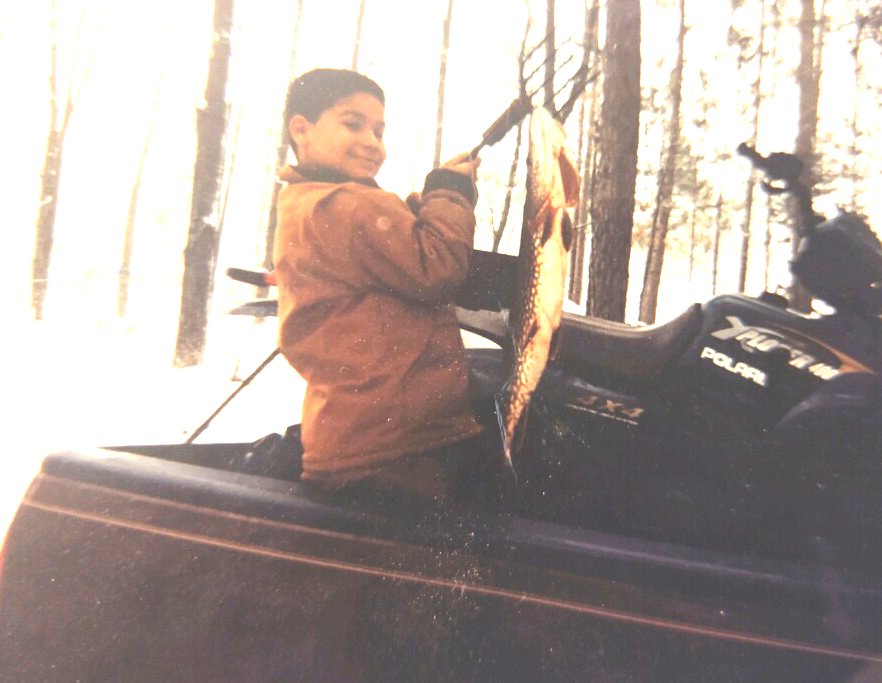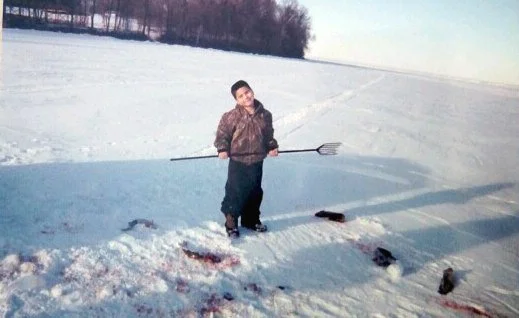Winter Spearing Offers Connection
Teaching youth the passions of loving the outdoors helps them learn to love the Earth as well as themselves. Here Benji is holding a nice morning's harvest to feed his family dinner at just 7 years old — a tradition he seeks to keep alive every winter.
By MASHKODE-BIZHIKIGAHBAW BENJI SAM
Spending time in a dark house has always been one of my favorite ways to spend time outside at the tail end of February and into March until the ice melts away. It’s the perfect early and late winter activity as the fish are shallow in numbers and provide a great time to sit over a decoy. My favorite spearing days lay ahead when the maple sap is running, the walleye and pike are near the shorelines, and the ice begins to honeycomb. Heading down to the lake to dump buckets and spear fish — what more could an Anishinaabe ask for?
I recently set out for a quick sit in high hopes for an Ogaa for dinner, setting up in the same location my family and I had placed our seasonal spear house on for each winter when I was growing up. This happens to be the same stretch of shoreline my grandfather, and my grandfather’s grandfather, overlooked on the lake all winter long in hopes of a successful fish hunt.
Our Anishinaabe relatives, in the not-so-distant past, would keep spear house lean-tos in these areas with a mix of slush and pine boughs in the holes to keep the ice open all winter long. It has been documented that many Native cultures across the world kept open holes in the ice for fish harvest in similar fashion. It always feels so surreal to be on the same water, fishing over the same rocks, and respecting the same lake that my ancestors did.
When I was young, my parents would make me tag along to help cut holes, scoop slush, pull ice chunks from the lake, and work the decoy my dad made. The fish weren’t always plentiful, but it always seemed that we got enough to eat. The last time I spent over a spearing hole, I sat in silence, alone, awaiting fish to swim by, and lost track of time. I fell into my memories of fishing with my dad, my brother, my cousins, and all the Elders who have taken that journey home. We owe it to those loved ones to continue spending time doing the things they loved, the things they fought so hard to keep, to honor them and their memory.
When you spend quality time outdoors, you begin to understand that the woods and water have a way of healing our souls. As Anishinaabe, our bodies draw energy from the earth around us, and when we treat that resource well, with gratitude, and make our offerings with our asemaa to those spirits that guide us in life, the earth has a way of bringing us what we need. Sometimes that means plentiful fish and other times it means acceptance, tranquility, and serenity.
That’s the beauty of spending so much time on the water in your life — you begin to understand the power that water has. It gives us life, it keeps us well, and it will always be home to us as Anishinaabe people. Throughout the years of spearing, netting, fishing, hunting, gathering, etc., it has become less and less about the harvest and more about the process, the appreciation, and who you can spend time and share that with.
To some it may feel like just another day spent on the water, but to me, a lifetime of experience awaits.
Benji at a young age shown spearing Mizay, eelpout, on Mille Lacs as they move into shore for spawning. Mizay are an Ojibwe delicacy and were often given as a sign of respect to the elders of the community.


